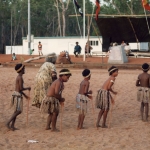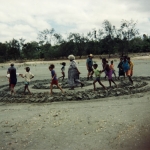About Thancoupie
Dr Thancoupie Gloria Fletcher (Thanakupi), AO, 1937 – 2011

Image supplied by Jennifer Isaacs |
Thancoupie was born Gloria James near Napranum, Weipa on the western coast of Cape York Peninsula, Far North Queensland. Thanakupi, or wattle flower, was her avay, or birth ritual name. Her early years were spent as a pre-school teacher and part-time artist, and it was not until 1969, when in her mid-thirties, that she gathered the courage to move from her remote home in the Cape to the urban environment of East Sydney Technical College. Here she began her training under the guidance of famed Australian ceramicists and artists including Peter Rushforth, Peter Travis, Derek Smith, Joan Grounds, Bernard Sahm, Mollie Douglas and the great Japanese potter Shiga Shigeo.
Thancoupies grace and charming personality enabled her to make friendships easily and created opportunities through the 1970s and 1980s to exhibit with the best artists, sculptors and craft-makers as a contemporary artist, rather than an Aboriginal Australian artist. She became friendly with the leaders of the Crafts Council of Australia (now Craft Australia), Marea Gazzard and Jane Burns, and was soon chosen to attend World Crafts Council events overseas. She met Bernice Murphy, and in 1983 travelled with her to São Paulo as Australia’s Cultural Commissioner to the 17th São Paulo Art Biennial. Her own solo exhibition of ceramic spheres subsequently toured Brazil and Mexico, as well as to Houston, USA.
Large spheres and ‘eggs’ were hand built and decorated with linear patterns telling legends through the interaction of totemic creatures on their surface. By combining naturalistic ceramic shapes with etched surface decoration Thancoupie created pots of great beauty, and in the process she became regarded as one of Australia’s greatest artists.

Image supplied by Jennifer Isaacs |
In total she produced more than 20 solo exhibitions in Australia and overseas, and with assistance from her close friend Jennifer Isaacs exhibited at many of Australia’s finest commercial galleries. In 2001, a survey exhibition took place at the Brisbane City Gallery. She is represented in all state collections, as well as major national cultural institutions. Her final great sculptural work, Eran 2010, stands at the entrance to the National Gallery of Australia.
Thancoupie spent much of the last 20 years of her life mentoring aspiring artists from communities in Far North Queensland, Arnhem Land, the desert, and the Tiwi Islands, as well as influencing Indigenous and non-Indigenous students enrolled in art and professional development courses. As a community leader she founded the Weipa Festival, and inspired many generations by running holiday programs to teach bush knowledge and art to younger generations. These were held consistently over 20 years and brought Weipa children in touch with the many ways Indigenous cultural practices and knowledge of the environment are part of art practice internationally. Teachers and workshop leaders came to participate from all over the world.
In 2006 she was awarded the Australia Council for the Arts’ Visual Arts Emeritus Award, appointed a Queensland Great in 2007 and between 2008 and 2010 led the Cairns Indigenous Art Fair as co-patron alongside the Governor of Queensland. She received two honorary Doctorates for her services to art and her work in reconciliation and community support.
Thancoupie′s arts philosophy – excerpts

Image supplied by Jennifer Isaacs |
Thancoupie’s approach to her art practice was always cultural, encompassing the whole of life and its meaning, the universe, and the interconnectedness of all living things. In this approach, all arts were as one, whether caring for land in the bush in creative ways, or expressing culture in what may be regarded as contemporary art. Examples of her philosophy include:
“When children sing you are with happiness.”
“Make the paperbark into candle holders like little boats to float down Bouchat Creek and out to sea. See they go in a circle – their little lights shining brightly in the sunset of the sandy beach, they are making the tail of Chaang, stingray fisherman. There he is!”
“We must honour our old people who went before, make headstones or memorials to tell the future who we were, who were Thaynakwith people, we have a culture and it is from this place. And there are songs and legends – so children can be proud of who they are.”
“I am the artist of this, from my mind. It is not for you to say how much or how – I am the owner of it.”
“The artist is the one to give the mind expression, to ‘design’ the way it is.”
“Artist can be talker, singer, manager, curator. Yes, dancer of course! And make the WORK. Make the MARK.”









